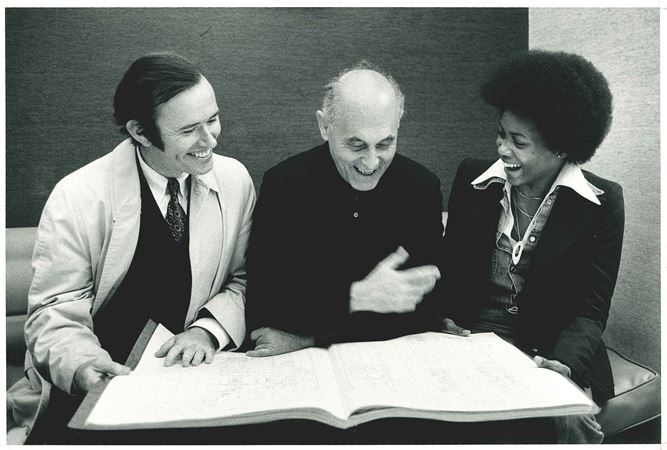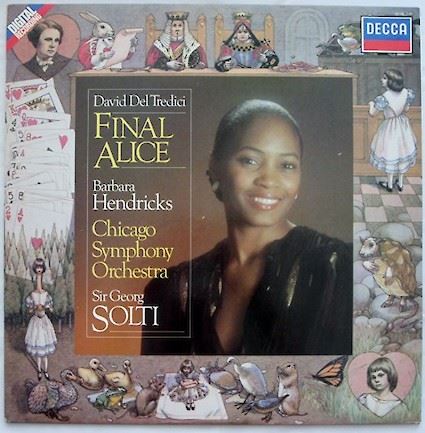David Del Tredici in 2015
Susan Johann
The Chicago Symphony Orchestra family joins the music world in mourning the loss of Pulitzer Prize–winning American composer David Del Tredici, who died on Saturday, November 18, 2023, at his home in Greenwich Village. He was 86.
In Orchestra Hall on October 7, 8, and 9, 1976, eighth music director Sir Georg Solti led the Chicago Symphony Orchestra in the world premiere performances of Del Tredici’s Final Alice. 27-year-old Barbara Hendricks was the soprano soloist. The work was performed again on October 26 and 27, 1979, and recorded by London Records with sessions on October 27, 1979, and January 29 and 30, 1980. The recording was produced by James Mallinson; James Lock, John Dunkerley and Michael Mailes were the recording engineers.
Most recently, the recording was re-released and included in the 108-CD set commemorating Solti’s complete Chicago Symphony Orchestra discography, and it also was featured on a recent nationally syndicated CSO radio broadcast, here. Solti’s marked score, used for the premiere, is now housed at Harvard University’s Loeb Music Library, and two pages can be seen here.
The composer supplied comments for the recording’s liner notes: “Final Alice, commissioned for the Chicago Symphony Orchestra by the National Endowment for the Arts in celebration of the U.S. Bicentennial . . . is dedicated to Sir Georg Solti. Scored for huge forces — an amplified soprano/narrator, a solo concertante group of folk instruments (mandolin, banjo, accordion, two soprano saxophones) and a very large orchestra — Final Alice unfolds a series of elaborate arias interspersed and separated by dramatic episodes from the last two chapters of [Lewis Carroll’s] Alice’s Adventures in Wonderland: the Trial in Wonderland (which gradually turns to pandemonium) and Alice’s subsequent awakening and return to ‘dull reality.’ To these I have added an Apotheosis. The work teeters between the worlds of opera and symphonic music, and were I to invent a category I would call Final Alice an ‘Opera, written in concert form.’
"Final Alice tells two stories at once; primarily, it is the tale of Wonderland itself, with all its bizarre and unpredictable happenings painted as vividly as possible. But between the lines, as it were, is the implied love of Lewis Carroll for Alice Liddell, as suggested by ‘Alice Gray’ and the Acrostic Song. By introducing these additional poems into the Trial as depositions of evidence, given by the White Rabbit (acting as a kind of chief prosecutor), I wished to bring that love story closer to the surface — not so close as to disturb the amusing, eccentric, sometimes terrifying story, but close enough to leave a recognition. I wished, that is, to add what one might call the human dimension of the man, seen only intermittently to be sure, but, hopefully, always affectingly — perhaps lingering in the memory after the dream of Wonderland itself has faded."


The Chicago Symphony Orchestra, under the baton of Michael Tilson Thomas, also gave the world premiere of Del Tredici’s March to Tonality, on June 13, 14, and 15, 1985. The composer provided the following for the program note: "March to Tonality [is] the first purely orchestral piece I have written since 1969 — the fateful year I met, compositionally speaking, Lewis Carroll, whose poetry and stories inspired all of my subsequent musical compositions. [The title] is an acrostic. The initial letters of each word (MTT) duplicate those of Michael Tilson Thomas. The coincidence is meant as a tribute. . . . Three times during the piece — at the start, at the conclusion of the Marcia Triste, and at the very end—I ask the orchestra to whisper the initials of my own name (DDT). Besides the obvious programmatic aspect to this, whispering has also the function of being a unique sound effect, clearly marking important structural moments as the work unfolds."
This is very similar to what the composer does at the conclusion of Final Alice, adding his own musical signature to the work. Again, in his words, "a 13-time repetition of a three-note figure on E [is] counted, in Italian, by the soprano, and are played on the crotale . . . The repetitions grow ever slower and softer, with the whisper-chorus joining the soprano on the recitation of the last number—’Tredici.’"
Numerous tributes have appeared online, including at the New York Times and OperaWire, among others.
This article also appears here.



